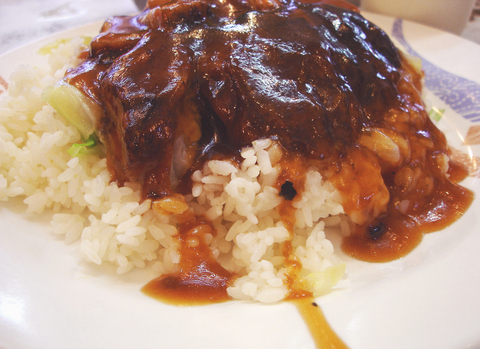More than one person has warned me away from eating at Feng Cheng, but nevertheless it's a popular hangout for lovers of Cantonese cuisine.
Across Xinsheng Road, from the side gate of NTU, Feng Cheng isn't big, but it's no hole in the wall, either, and the round family-sized tables filled up while I ate an early dinner there.
It's not hard to figure out why one might be wary of Feng Cheng: They do the dishes and cook the food in grungy-looking rooms in plain sight of the dining area, sausages hang on colored yarn against the plaster walls, and the green plastic dishes are kept in piles on the tables.

PHOTO: CHRIS PECHSTEDT, TAIPEI TIMES
As for the food, it tastes full of what to the palate are valuable oils, salts, and MSGs. One gets the feeling eating it that one's innermost organs are none too pleased.
And yet there is something worthwhile about this place. The food is appealing, in its own salty sort of way. There are Cantonese staples like shacha (沙茶) and he-fen (河粉) -- a tasty flat noodle you can get with most dishes -- and the barbequed pork (叉燒) and barbecued duck (燒鴨) are said to be famous.
The duck dish came with half an order of pork and at least one of the two meats was pretty good. The kitchen is definitely overzealous with the sauce, though.
One of the nice parts about Feng Cheng is that, even if the food is a bit much for some people, they aren't stingy with the vegetables or the fungi; the abundance of greens and mushrooms often successfully takes the edge off the salt.
Feng Cheng isn't good in the way of the fancy-schmancy NT$300-a-plate stuff we often review, but it does have a sort of guilty appeal similar to that of a greasy family-owned burger joint.
A warning to anyone squeamish around dead animals: The meat is stored in a glass booth that is visible from both the street and the dining area. It's not possible to avoid the sight of dozens of cooked but still very recognizable birds hanging by a single leg. If that sort of thing bothers you, steer clear.
It's certainly possible to find better food in Gongguan for the same price or less, so Feng Cheng is not necessarily the kind of place you'd want to do time on the MRT for, but if you're in the area and you're in the mood for something kind of salty and unhealthy you could do a lot worse -- assuming you aren't faint of stomach.

April 14 to April 20 In March 1947, Sising Katadrepan urged the government to drop the “high mountain people” (高山族) designation for Indigenous Taiwanese and refer to them as “Taiwan people” (台灣族). He considered the term derogatory, arguing that it made them sound like animals. The Taiwan Provincial Government agreed to stop using the term, stating that Indigenous Taiwanese suffered all sorts of discrimination and oppression under the Japanese and were forced to live in the mountains as outsiders to society. Now, under the new regime, they would be seen as equals, thus they should be henceforth

Last week, the the National Immigration Agency (NIA) told the legislature that more than 10,000 naturalized Taiwanese citizens from the People’s Republic of China (PRC) risked having their citizenship revoked if they failed to provide proof that they had renounced their Chinese household registration within the next three months. Renunciation is required under the Act Governing Relations Between the People of the Taiwan Area and the Mainland Area (臺灣地區與大陸地區人民關係條例), as amended in 2004, though it was only a legal requirement after 2000. Prior to that, it had been only an administrative requirement since the Nationality Act (國籍法) was established in

With over 80 works on display, this is Louise Bourgeois’ first solo show in Taiwan. Visitors are invited to traverse her world of love and hate, vengeance and acceptance, trauma and reconciliation. Dominating the entrance, the nine-foot-tall Crouching Spider (2003) greets visitors. The creature looms behind the glass facade, symbolic protector and gatekeeper to the intimate journey ahead. Bourgeois, best known for her giant spider sculptures, is one of the most influential artist of the twentieth century. Blending vulnerability and defiance through themes of sexuality, trauma and identity, her work reshaped the landscape of contemporary art with fearless honesty. “People are influenced by

The remains of this Japanese-era trail designed to protect the camphor industry make for a scenic day-hike, a fascinating overnight hike or a challenging multi-day adventure Maolin District (茂林) in Kaohsiung is well known for beautiful roadside scenery, waterfalls, the annual butterfly migration and indigenous culture. A lesser known but worthwhile destination here lies along the very top of the valley: the Liugui Security Path (六龜警備道). This relic of the Japanese era once isolated the Maolin valley from the outside world but now serves to draw tourists in. The path originally ran for about 50km, but not all of this trail is still easily walkable. The nicest section for a simple day hike is the heavily trafficked southern section above Maolin and Wanshan (萬山) villages. Remains of